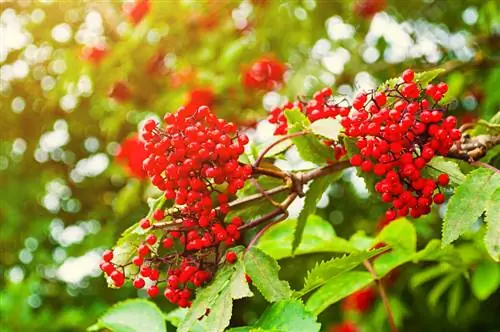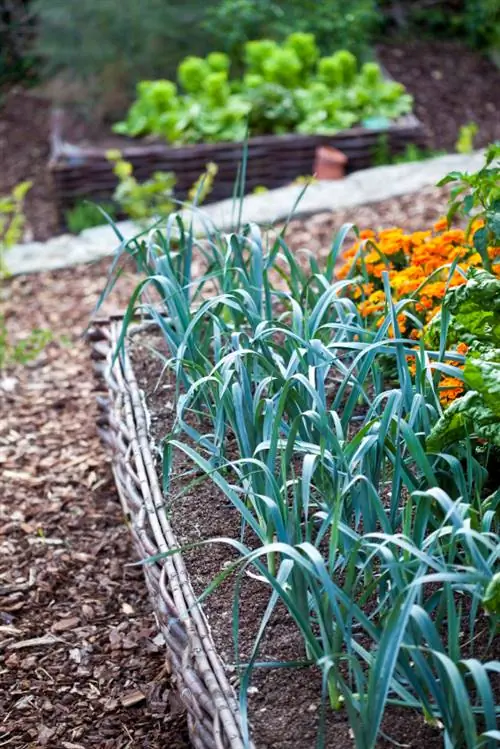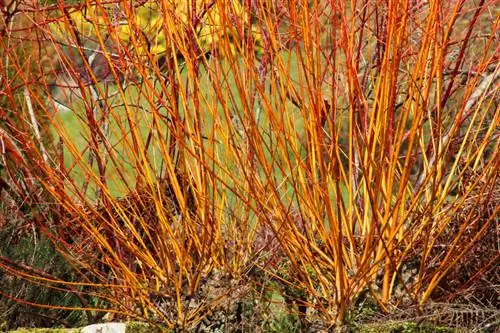- Author admin [email protected].
- Public 2024-01-10 23:11.
- Last modified 2025-01-23 11:22.
With wild charm, subtle flowers and bright red berry decorations, red elderberry acts as a reliable privacy screen, impressive solitaire and decorative gap filler. Are you still worried about unanswered questions about proper cultivation? Then you will discover the right answers here with hand and foot.

How do I properly care for a red elderberry?
Red elderberry is an attractive shrub that serves as a privacy screen, solitary plant or gap filler. It prefers sunny to partially shaded locations with humus-rich, well-drained and fresh to moderately dry soil. Care includes regular watering, fertilizing and, if necessary, cutting.
Planting elderberry correctly
Autumn is the time to plant red elderberries. Choose a sunny to partially shaded location where the shrub has humus-rich, well-drained and fresh to moderately dry soil. Before you start preparing the soil there, place the still potted young plant with the root ball in a bucket of water. Then loosen the soil thoroughly to incorporate a generous portion of compost, bark humus or leaf mold. This is how the planting process continues:
- Dig a spacious planting pit
- Mix the excavated material with horn shavings and compost
- If necessary, provide the hollow with a root barrier made of geotextile all around
- Unpot the bush to plant it exactly as deep as before
- Press the soil and water
A mulch layer of autumn leaves or bark mulch has a beneficial effect on rooting. To ensure that the shrub thrives magnificently in a group or as a hedge, create the next pits 100-150 cm apart.
Care tips
So that the wild ornamental shrub meets expectations, the following care program is used:
- Water the bush as soon as the soil surface has dried
- From March to August, fertilize every 14 days with compost, bark humus or nettle manure
- Carry out light topiary immediately after flowering or harvesting
- Radical pruning is possible during the leafless period up to 50 cm above the ground
In the weeks and months after planting, an adequate supply of water is essential for vital rooting. While an adult shrub tolerates short-term drought well-naturedly, a young red elderberry must not dry out.
Which location is suitable?
In the wild, the decorative white flowers and bright red berries can be discovered in sparse riparian forests. The shrub likes to associate with deciduous trees or find a place in mixed forests. This results in the following criteria for choosing a location in the home garden:
- Sunny to semi-shady location
- Nutritious, humus-rich soil
- Fresh-moist to moderately dry, without waterlogging
Red elderberry is tolerant of soil acidity. The shrub likes to extend its powerful roots in slightly acidic, neutral to slightly alkaline soil.
The correct planting distance
Considering its majestic habit and extensive root system, we recommend a planting distance of at least 100-150 cm. If you plant the mighty shrub near buildings, the distance to the walls should be 200-250 cm.
What soil does the plant need?
The broad location amplitude of a red elderberry is expressed not least in the frugal demands on the soil. Basically, the shrub thrives in any normal garden soil. In order to get the most out of this gem, the soil should be loose, humus-rich, nutrient-rich and fresh-moist to moderately dry in structure. A neutral to alkaline pH value is perfectly fine, especially since the elderberry appreciates a little lime.
When is flowering time?
The cream-colored flowers appear in April and attract pollinators until May. Unfortunately, red elderberry cannot hold a candle to its big brother, the black elderberry, when it comes to scent. In fact, it is precisely the somewhat unpleasant smell that attracts insects. At first glance, you can't tell from the multi-flowered umbrella panicles that the furious, bright red fruit decorations develop in autumn.
Cut elderberry correctly
Cut a red elderberry between October and March when the bush outgrows you. During the leafless period, radical pruning is easily tolerated. Use pruning shears or a saw and shorten shoots that are too long to 50 cm. Since the wild tree always blooms on the previous year's wood, in this case the flower fails. In order to trim the ornamental shrub just a little into shape, we recommend an appointment immediately after the flowering period or in the autumn after the harvest. Place the scissors just above an outward-facing, sleeping eye. You can recognize a sleeping eye as a slight bump under the bark. Additionally, thin out the shrub thoroughly in early spring by cutting off all dead wood at the base.
Watering elderberry
As a shallow-rooted shrub, the shrub quickly comes under drought stress in summer if there is no rain. Therefore, water thoroughly when it is dry. It is beneficial to run the garden hose for 10 minutes once or twice a week. If you only give a little water every day, the already shallow roots will decrease even further.
Fertilize elderberry properly
Red elderberry is not a food contempt. The shrub attaches great importance to a regular supply of nutrients. Therefore, from March to August, fertilize every 14 days with compost, horn shavings, bark humus or plant manure. If this effort is too great for you, apply a slow-release fertilizer in March and June.
Propagate elderberries
To grow more specimens of the red elderberry, you can choose from the following propagation methods:
- Cut half-woody cuttings in summer, plant them in pots and let them root until autumn
- Sowing the seeds behind glass at a constant 20 degrees Celsius in a partially shaded location
Before you sow the seeds, they go through stratification. As cold germinators, the seeds stay in a bag with moist sand at + 4 to - 4 degrees Celsius in the vegetable compartment of the refrigerator for 6-8 weeks.
Is elderberry poisonous?
Red elderberry contains poisonous sambunigrin in all parts of the plant. This toxin causes nausea, vomiting and shortness of breath in humans and animals. Therefore, warn your children about eating the red berries. Dogs, cats, rabbits or guinea pigs should not be fed the leaves, flowers or berries because in the worst case scenario they will die. The poison dissolves at temperatures above 80 degrees Celsius, making the berries suitable for making jam, jelly or syrup. However, this does not apply to the seeds, which retain their toxic content. Therefore, only use the fruits after careful juicing.read more
Is red elderberry edible?
The red berries are not suitable for fresh consumption. The sambunigrin it contains causes severe symptoms of poisoning. Only after the fruits have been heated to more than 80 degrees Celsius does the toxin dissolve. The seeds, however, defy any attempt to decompose the toxic ingredient. Red elderberry is only edible when juiced. Prepared as a refreshing jam or aromatic syrup, the red elderberries can be used in the household.read more






